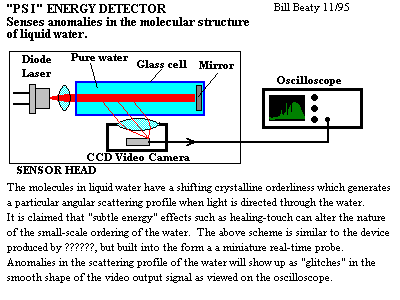Weird Research, Anomalous Physics
DETECTOR FOR PSI "FIELDS?"

|
This suggested detector operates by graphing the Mie optical scattering distribution of pure water in realtime on an oscilloscope. The article by the original investigators Pyatnitsky and Fonkin [1] appeared in the Journal of Scientific Exploration where the investigators used a physically-moving photomultiplier tube to measure the angular scattering curve. They found some people to have the ability to distort the scattering curve by focusing "healing energy" on the water samples, and the graph developed peaks and "noise" at particular spots, with no conventional explanations.
One of their subjects was able to produce a scattering maximum at
135deg which was about one hundred times larger than that of normal water,
as if the water's crystalline microstructure was forced to exist only
across a small range of sizes. Other subjects produced effects up to a
couple of s.d. away from the control sample baseline, demonstrating that
the results are not swamped by noise. One subject produced scattering
distortions lasting hours, after just a 40 second "treatment," while
others only lasted during the time an "effort" was being made. 15 people
were tested, and about 1/4 of these could produce an evident effect. By
displaying the graph as operator feedback, subjects could be trained to
improve their skill at obtaining the effect.
My idea depicted in the above diagram is only a suggestion and has NOT
been tested. A Photomultiplier was used by the original investigators,
but if the CCD camera is sensitive enough it should serve. The
orientation of the camera and laser beam is important, since the relative
angle determines which part of the scattering curve will be displayed.
Elimination of reflections, and efficient beam-dump would be significant
issues. A simple lens of very short focal length placed very close to the
CCD may be necessary in order to plot a wide distribution of scattering
angles. The original experiment recorded angles between about 30 and 160
degrees, with interesting results at several different angles. Distilled
water, or even tap water is said to work.
To inhance sensitivity and eliminate noise, the laser diode could be
pulsed at 15.7Khz line scan rate, and the camera output then synchronously
demodulated by way of a 1-line buffer.
I've not tried building this device, so it's open to experimentation to
find out if it will actually produce the results claimed in the JSE
article. A quick test shows that a .5mW laser diode gives scattering
output which is nearly too low for dark-adapted human eyes to detect, much
less for that of a video camera. So try a 10mW laser instead!
Another idea: if a suitable wide-angle eyepiece was held very close to a laser beam in a water cell, the lens would allow DIRECT VIEWING of the angular scattering distribution. No good for precision measurments, but excellent for convincing the skeptical that these effects are real. Peaks in the Mie scattering curve would be seen as bright vertical stripes in a fuzzy broad band of laser light. With a bright laser, perhaps realtime changes in water's structure would be directly visible to the human eye, no electronics required.